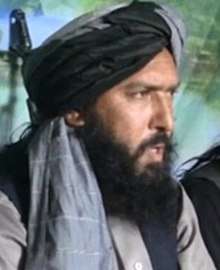Hafiz Saeed Khan
Hafiz Saeed Khan (1972 – 26 July 2016[1]) was an Islamic militant who served as the Islamic State emir for its Khorasan province, which is active in Afghanistan and Pakistan, from January 2015 until his death in July 2016. Prior to 2015, Khan was a senior commander in the Tehrik-i-Taliban Pakistan and initially a member of the Afghan Taliban.
Hafiz Saeed Khan | |
|---|---|
 | |
| Birth name | Hafiz Saeed Khan |
| Born | 1972 Orakzai Agency, Federally Administered Tribal Areas, Pakistan |
| Died | 26 July 2016[1][2] Achin District, Nangarhar Province, Afghanistan |
| Allegiance | |
History
Early life
Saeed was born in 1972 in the town of Mamozai in the Orakzai Agency, in the Federally Administered Tribal Areas of Pakistan near the Afghan border. He got his early education from a local cleric, Mulana Shabit, before moving to the Hangu District of Khyber Pakhtunkhwa, where he was admitted to the local school known as Darululoom Islamia Hangue.
Sources say a man called Farooq Khan, who belonged to Saeed's village, arranged his marriage with his cousin. Saeed has two sons and one daughter with his wife, and according to Farooq, has since taken a second wife in the region of North Waziristan.
Islamic militancy
Tehrik-i-Taliban Pakistan
After the September 11 attacks, Saeed went to Kabul to fight against the United States invasion of Afghanistan with the Afghan Taliban. He remained in Kabul for two years.
He became close to Baitullah Mahsud, who formed the Tehrik-i-Taliban Pakistan in 2007 and became its leader. He appointed Saeed to the majlis ash-shura and made him emir for Orakzai Agency.
On August 2009, Baitullah Mahsud was killed in an American drone strike. A dispute arose as to the leadership of the TTP, with some commanders wanting Hakimullah Mahsud to assume the leadership, while Saeed wanted his ally Wali Ur Rahman to become the leader. According to Abdul Saboor Khan, a renowned analyst of tribal affairs, "The TTP split in two groups after Baitullah's killing and Saeed was not happy over the differences," In 2013 Hakimullah was himself killed in an American drone strike. "Saeed was one of the three main contenders for the top slot of the TTP chief, and I think he was disheartened when Fazlullah was nominated", Khan said.
Islamic State
On 15 October 2014, Saeed left the TTP, along with five other Taliban leaders, and pledged allegiance to Islamic State leader Abu Bakr al-Baghdadi. The other men who left alongside him were the TTP's former spokesman, Shahidullah Shahid; its Khyber Agency chief, Gul Zaman; Peshawar chief Mufti Hassan; Kurram Agency chief Hafiz Quran Daulat, and Hangu chief Khalid Mansoor.
Saeed's position as head of IS Khorasan was confirmed in a video message released by the group on 11 January. The video features a message by Shahidullah Shahid.[3]
The 13th issue of Dabiq (magazine), titled "The Rafidah from Ibn Saba' to the Dajjal" and published 19 January 2016, features an interview with Saeed.[4]
US sanctions
On 29 September 2015, the United States Department of the Treasury sanctioned Saeed alongside 15 other Islamic State leaders. According to the Department of the Treasury, "Khan, as leader of ISIL-K, plays a central role in expanding ISIL’s operations in the region, commanding militants and coordinating the delivery of supplies and munitions, the travel of associates, and other arrangements. In mid-2015, Khan appointed ISIL representatives in Kunar Province and Nangarhar Province, Afghanistan and approved funding for the establishment of a training camp for ISIL fighters in western Afghanistan. ISIL militants under Khan’s command had taken control of several districts in Nangarhar Province in mid-2015".[5]
Death
On 12 July 2015, the Afghan intelligence agency, the National Directorate of Security, claimed that Saeed was killed in a strike carried out by US-led coalition forces in coordination with intelligence provided by the spy agency, though the United States never confirmed such an operation. The Islamic State rejected the claim, but the strike did kill Shahidullah Shahid and Gul Zaman, according to senior IS leader Abdul Rahim Muslim Dost.[6]
On 12 August 2016, the United States announced that Hafiz Saeed Khan was killed in a U.S. airstrike in Achin district of Afghanistan's Nangarhar Province. There was no immediate response from the group itself, and it was initially unknown who would succeed him.[1] In the event he was succeeded by Abdul Hasib, who was in turn killed by Afghan and US Special Forces in Nangarhar on 27 April 2017.[7]
References
- "Top ISIS commander killed in U.S. airstrike in Afghanistan". BNO News. 12 August 2016. Archived from the original on 16 March 2018. Retrieved 12 August 2016.
- "IS leader in Afghanistan killed, US believes". BBC News. 12 August 2016. Retrieved 12 August 2016.
- Sajid, Islamuddin (19 January 2015). "Hafiz Saeed Khan: The former Taliban warlord taking Isis to India and Pakistan". International Business Times. Peshawar, Pakistan. Retrieved 10 July 2016.
- Desai, Shweta (22 January 2016). "We will expand to Kashmir and kill cow-worshipping Hindus: Islamic State in Dabiq". DNA India. Retrieved 10 July 2016.
- "Treasury Sanctions Major Islamic State of Iraq and the Levant Leaders, Financial Figures, Facilitators, and Supporters". 29 September 2015. Retrieved 10 July 2016.
- "Islamic State leader in Afghanistan 'killed by drone'". BBC News Online. BBC Online. BBC. 12 July 2015. Retrieved 10 July 2016.
- Reuters (8 May 2017). "Head of Isis in Afghanistan confirmed killed in joint US operation". The Guardian. Guardian News & Media Limited. Retrieved 3 July 2019.